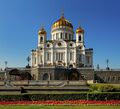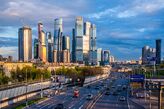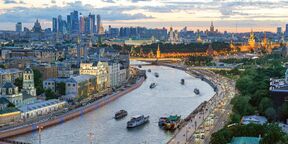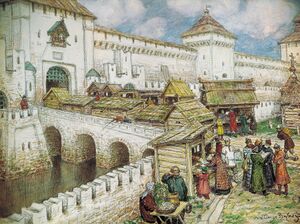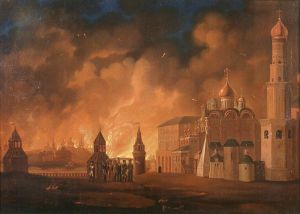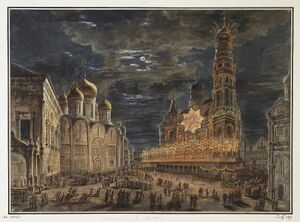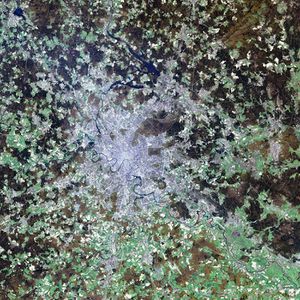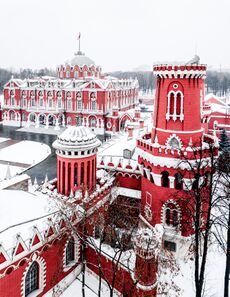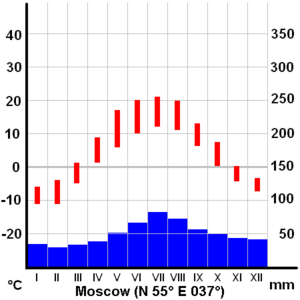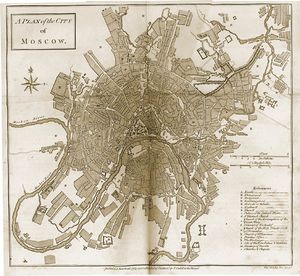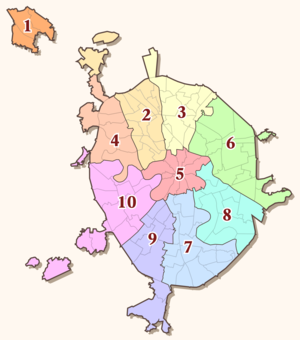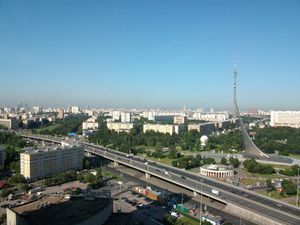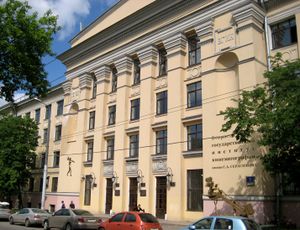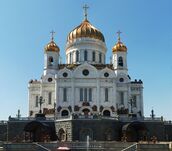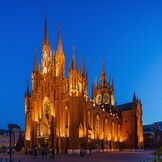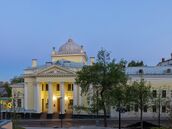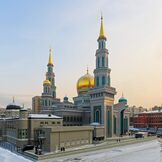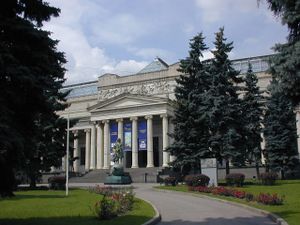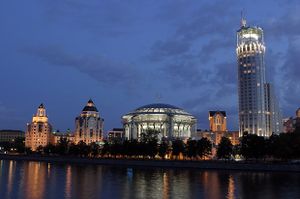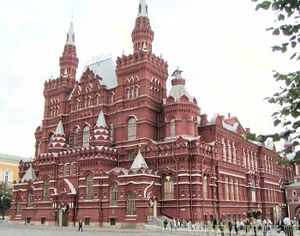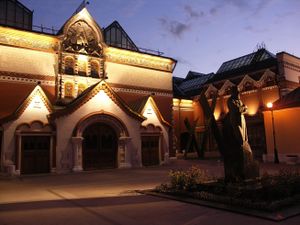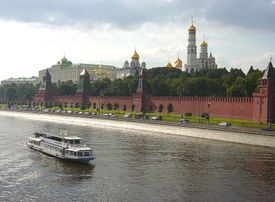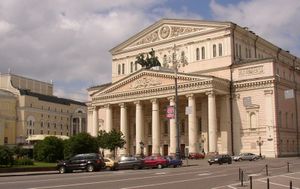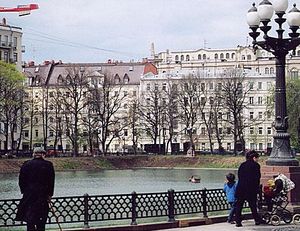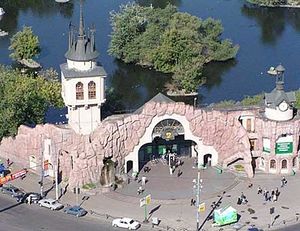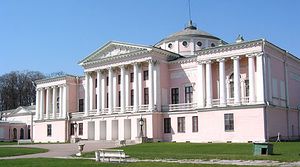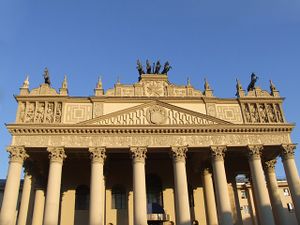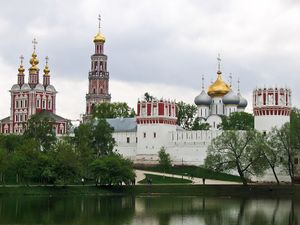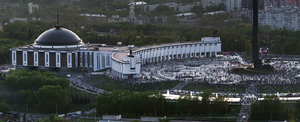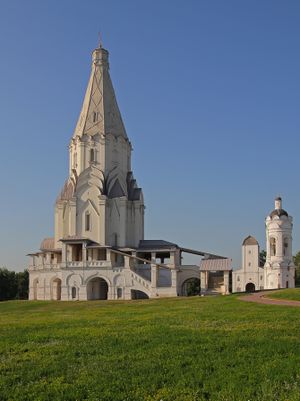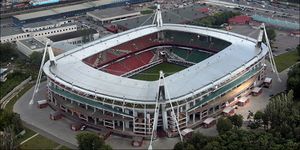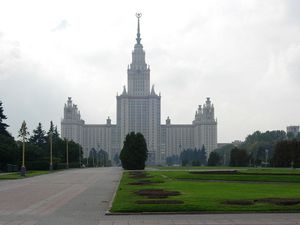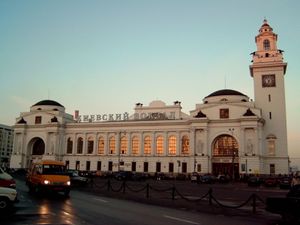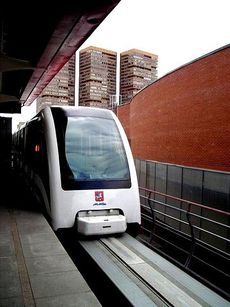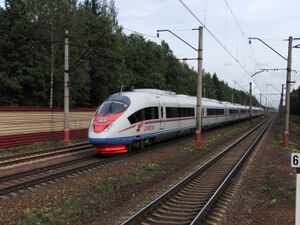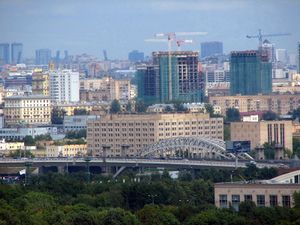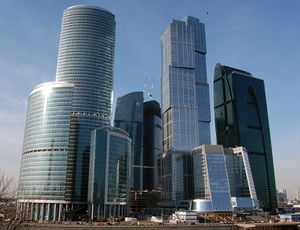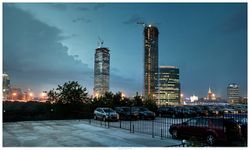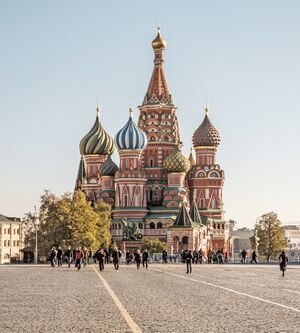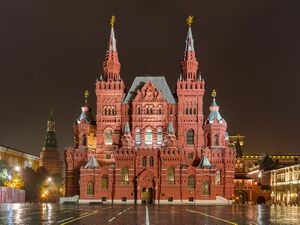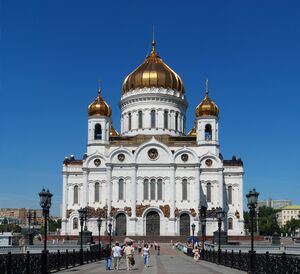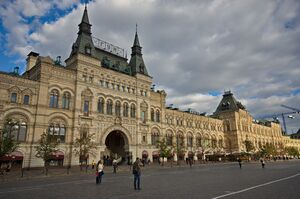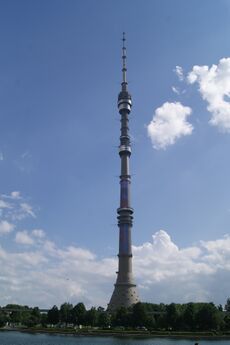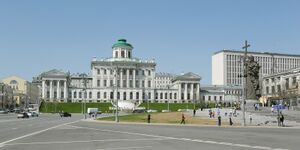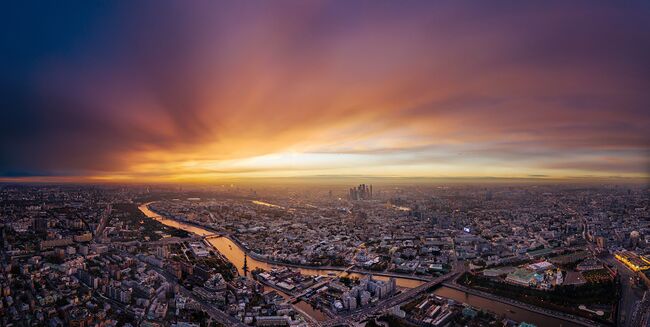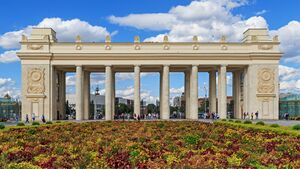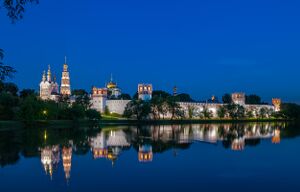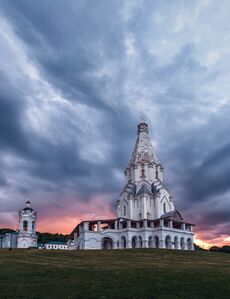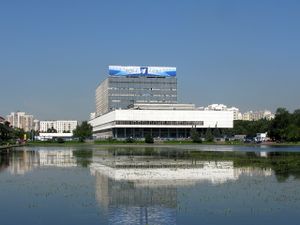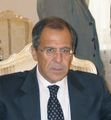موسكو
موسكو
Москва Moscow | |
|---|---|
Red Square with the Spasskaya Tower (left), Saint Basil's Cathedral (right) and Ostankino Tower (background) View along the Moskva River with the Kremlin (right) and the Moscow International Business Center (left) | |
| النشيد: "My Moscow" | |
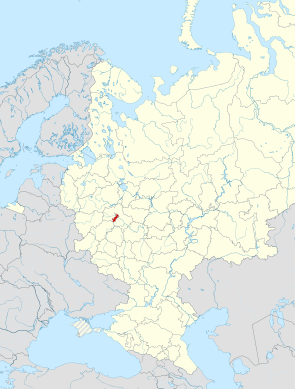 | |
| الإحداثيات: 55°45′21″N 37°37′2″E / 55.75583°N 37.61722°ECoordinates: 55°45′21″N 37°37′2″E / 55.75583°N 37.61722°E | |
| البلد | |
| Federal district | Central |
| Economic region | Central |
| First mentioned | 1147[1] |
| الحكومة | |
| • الكيان | City Duma[2] |
| • Mayor[3] | Sergey Sobyanin[3] |
| المساحة | |
| • Total | 2٬561٫5[4] كم² (989٫0 ميل²) |
| • الحضر | 6٬154 كم² (2٬376 ميل²) |
| • Moscow capital region | 48٬360 كم² (18٬670 ميل²) |
| المنسوب | 156 m (512 ft) |
| التعداد | |
| • Total | |
| • الترتيب | 1st |
| • الكثافة | 5٬080/km2 (13٬200/sq mi) |
| • Urban | |
| • الكثافة الحضرية | 2٬762/km2 (7٬150/sq mi) |
| • العمرانية | |
| • الكثافة العمرانية | 450/km2 (1٬200/sq mi) |
| صفة المواطن | Muscovite |
| GDP | |
| • Federal city | ₽24.471 trillion US$332 billion (2021) |
| • Per capita | ₽1,935,205 US$26,257 (2021) |
| منطقة التوقيت | UTC+3 (MSK[10]) |
| ISO 3166 code | RU-MOW |
| لوحة السيارة | 77, 177, 777; 97, 197, 797; 99, 199, 799, 977[11] |
| OKTMO ID | 45000000 |
| الموقع الإلكتروني | mos.ru |
موسكو (بالروسية: Москва ، وتنطق: مـَسـْكـڤا) عاصمة روسيا،وتقع في الجزء الأوربي من البلاد وسط السهل الروسي وعلى ضفاف نهر موسكوفا الذي يرتبط بنهر الڤولگا Volg بقناة طولها 130كم. تبلغ مساحة المدينة 879 كم²، وارتفاعها عن سطح البحر 130م، تتميز بمناخ بارد (متوسط الحرارة في كانون الثاني/يناير -10 ْ، وتموز/ يوليو 10 ْ، معدل هطل الأمطار السنوي 640مم). وتغطي اجمالي مساحة مقداره 878.7 كم²، عدد السكان في تزايد ووصل في إحصاء عام 2004 إلى 11.2 مليون نسمة. حسب التقسيم الإداري للكيانات الفدرالية لروسيا فموسكو هي أحد مدينتين فدراليتين (مع سانت پطرسبرگ) وتقع داخل المنطقة الفدرالية المركزية.
وبتعداد أكثر من 10 مليون نسمة فإن ترتيب موسكو بين دول العالم من حيث التعداد هو الحادي والعشرون. وهي أكبر وأكثر المدن تطوراً في روسيا وتجذب موسكو اهتمام المستثمرين بسبب البنية التحتية المتقدمة، والعدد الكبير من السكان، وعدد كبير من الفرص التجارية.
. . . . . . . . . . . . . . . . . . . . . . . . . . . . . . . . . . . . . . . . . . . . . . . . . . . . . . . . . . . . . . . . . . . . . . . . . . . . . . . . . . . . . . . . . . . . . . . . . . . . . . . . . . . . . . . . . . . . . . . . . . . . . . . . . . . . . . . . . . . . . . . . . . . . . . . . . . . . . . . . . . . . . . . .
التاريخ
أصل كلمة موسكو غير معروف، على الرغم من وجود عدة نظريات. نظرية واحدة تشير إلى ان مصدر الاسم اللغة الروسية القديمة فالمدينة تحمل اسم النهر، والذي يعني "الظلام" و "عكر". أول إشارة إلى موسكو في الروسية في الفترة من 1147 . واصبحت موسكو امارة مستقلة في 1327 . موسكو تطورت لتصبح مستقرة ومزدهره لسنوات عديدة ، وساهمت في جذب عدد كبير من اللاجئين من سائر انحاء روسيا
نشأة موسكو
لم يُعرف متى سكن الناس موسكو، فأول تاريخ ذكر عنها عام 1147م، حيث كانت تقع ضمن ملكية الأمير الروسي يوري دولجوركي. كان موقع المدينة على طريق تجاري مهم، فنمت وازدهرت. احتل التتار موسكو وأراضي روسيا في القرن الثالث عشر الميلادي، وأجبروا الأمير الروسي على الاعتراف بحكم التتار ودفع الضر|ئب.
خلال القرن الرابع عشر الميلادي، جمع أمراء موسكو الضرائب للتتار، ووسعوا أراضيهم بشراء أراض جديدة، أو بالسيطرة على أراضي الأمراء المنافسين. وفي أواخر القرن الخامس عشر الميلادي، أصبحت موسكو أقوى مدينة روسية. وتخلصت من حكم التتار في أواخر القرن الخامس عشر الميلادي، وذلك في عهد إيفان الثالث الملقب بالعظيم. وأصبح حفيده إيفان الرابع الملقب بإيفان الرهيب قيصر روسيا في عام 1547م، وكانت موسكو عاصمته.
نمت موسكو بسرعة في القرن السابع عشر الميلادي، وبنى القياصرة قصورًا في الكرملين، وظهرت كنائس وأديرة جديدة، وتطورت الصناعة. وفي عام 1712م، نقل بيتر الأول، الملقب بالعظيم، العاصمة إلى سانت بطرسبرج، ولكن موسكو بقيت مركزًا حضاريًا وتجاريًا مهمًا.
| 1147 | أنشأ يوري دولجوركي، أمير الإقليم مدينة موسكو. |
| ق 13 | احتل التتار موسكو. |
| أواخر ق 15 | أنهى إيفان الثالث حكم التتار. |
| 1703 | بدأ بيتر الأول بناء العاصمة الجديدة سانت بطرسبرج. |
| 1918 | أصبحت موسكو عاصمة للبلاشفة. |
| 1939-1945 | دمر سلاح الجو الألماني المدينة خلال الحرب العالمية الثانية. |
| 1960 | اتباع مخطط جديد ضاعف مساحة المدينة. |
| 1980 | احتضنت موسكو الألعاب الأوليمبية الصيفية، وهي أول مدينة سوفييتية تحتضن الألعاب الأوليمبية. |
| 1985 | أصبـح ميخائيـل جورباتشوف زعيمًا للحزب الشيوعي. |
| 1991 | استقـال الرئيس جورباتشوف وحل الاتحاد السوفييتي السابق. |
النيران أحرقت معظم موسكو في عام 1812م، ويعتقد أن النار أشُعلت بوساطة الجنود الروس المنسحبين أمام الجيش الفرنسي بقيادة نابليون الأول. ويوجد اعتقاد بأن بعض أفراد الجيش الفرنسي أشعلوا هذه النيران.
الگراندوقية (1283–1547)
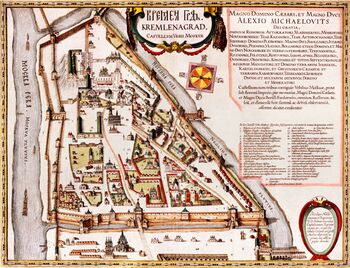
|
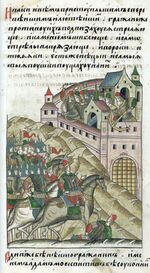
|
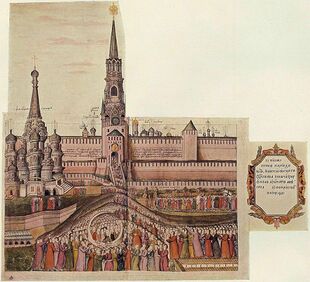
|
| كرملن موسكو في أواخر القرن 16 | حصار موسكو | الميدان الأحمر |
حكم دانيال موسكو كگراندوق حتى 1303 وأسسها كمدينة مزدهرة سوف تتفوق على إمارتها الأم ڤلاديمير بحلول ع1320.
على الضفة اليمنى لنهر موسكڤا، على بعد 8 كيلومتر من الكرملن، ليس بعد 1282، أسس دانيال أول دير بالكنيسة الخشبية للقديس دانيال-ستيليت، الذي هو الآن دير دانيلوڤ. توفي دانيال في 1303، في عمر 42. وقبل وفاته، أصبح راهباً وحسب وصيته، دُفِن في مقبرة دير القديس دانيال.
القيصرية (1547–1721)
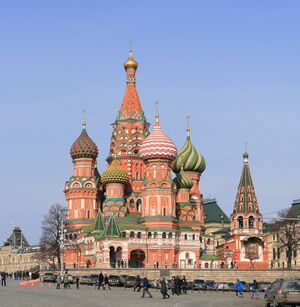
في القرنين 16 و 17، بـُنيت الدفاعات الدائرية الثلاث: كيتاي-گورود (Китай-город)، المدينة البيضاء (Белый город) والمدينة الترابية (Земляной город). إلا أنه في 1547، دمر حريقان معظم البلدة، وفي 1571 استولى تتار القرم على موسكو، وأحرقوا كل شيء عدا الكرملن.[12] وتسجل الحوليات أن فقط 30,000 شخص من أصل 200,000 ساكن قد نجوا.
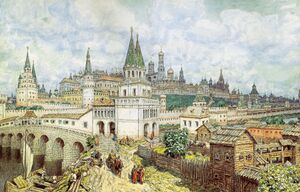
Crimean Tatars attacked again in 1591, but this time were held back by new defense walls, built between 1584 and 1591 by a craftsman named Fyodor Kon. In 1592, an outer earth rampart with 50 towers was erected around the city, including an area on the right bank of the Moscow River. As an outermost line of defense, a chain of strongly fortified monasteries was established beyond the ramparts to the south and east, principally the Novodevichy Convent and Donskoy, Danilov, Simonov, Novospasskiy, and Andronikov monasteries, most of which now house museums. From its ramparts, the city became poetically known as Bielokamennaya, the "White-Walled". The limits of the city as marked by the ramparts built in 1592 are now marked by the Garden Ring.
Three square gates existed on the eastern side of the Kremlin wall, which in the 17th century, were known as Konstantino-Eleninsky, Spassky, Nikolsky (owing their names to the icons of Constantine and Helen, the Saviour and St. Nicholas that hung over them). The last two were directly opposite the Red Square, while the Konstantino-Elenensky gate was located behind Saint Basil's Cathedral.
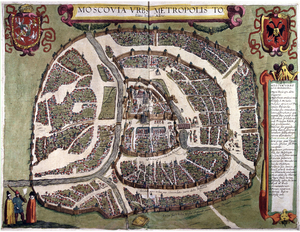
. . . . . . . . . . . . . . . . . . . . . . . . . . . . . . . . . . . . . . . . . . . . . . . . . . . . . . . . . . . . . . . . . . . . . . . . . . . . . . . . . . . . . . . . . . . . . . . . . . . . . . . . . . . . . . . . . . . . . . . . . . . . . . . . . . . . . . . . . . . . . . . . . . . . . . . . . . . . . . . . . . . . . . . .
الامبراطورية (1721–1917)
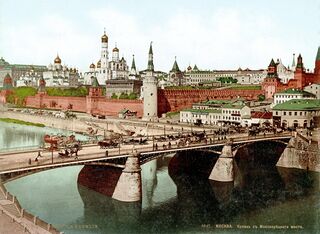
After losing the status as the capital of the empire, the population of Moscow at first decreased, from 200,000 in the 17th century to 130,000 in 1750. But after 1750, the population grew more than tenfold over the remaining duration of the Russian Empire, reaching 1.8 million by 1915. The 1770–1772 Russian plague killed up to 100,000 people in Moscow.[13]
التدمير والتجديد
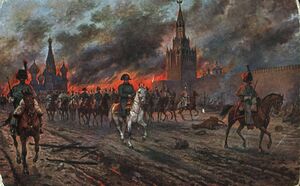
احتلت الجيوش الفرنسية بقيادة نابليون الأول موسكو في عام 1812، بعد أن انتصرت على الروس في معركة بوردينو، وهَجر السكان المدينة، فدخلها نابليون بسهولة. وبعد أيام أحرِقَت المدينة، ويعتقد بعض المؤرخين أن الروس المنسحبين، أشعلوا النار في المدينة. ويشير آخرون إلى أن بعض أفراد الجيش الفرنسي أشعلوا النيران. وبعد نحو شهر، انسحب جيش نابليون من المدينة أثناء شتاء روسيا القارس.
Moscow State University was established in 1755. Its main building was reconstructed after the 1812 fire by Domenico Giliardi. The Moskovskiye Vedomosti newspaper appeared from 1756, originally in weekly intervals, and from 1859 as a daily newspaper.
The Arbat Street had been in existence since at least the 15th century, but it was developed into a prestigious area during the 18th century. It was destroyed in the fire of 1812 and was rebuilt completely in the early 19th century.
بدأ إعادة بناء موسكو فورًا، فبُنيت المساكن، وظهرت المصانع. وفي منتصف القرن التاسع عشر الميلادي، اشتهرت موسكو بوصفها مركزًا روسيا للسكك الحديدية والصناعة. وازداد عدد سكان المدينة بسرعة، ففاق المليون نسمة في عام 1900.
أوائل القرن العشرين
حدثت ثورات قوية ضد القيصر في عامي 1905م و1917م في عدة مدن روسية. وفي ثــورة عام 1917م وقعت الحكومــة تحت سيطــرة البلاشفـة (أعضـاء الحزب الشيوعي)، الذين نقلوا العاصمة إلى موسكو في عام 1918م. انظر: البلاشفة.
تطورت موسكو بسرعة في الثلاثينيات من القرن العشرين، وفي الحرب العالمية الثانية (1939 - 1945م) تقدمت الجيوش الألمانية ووصلت إلى المدينة، ولكنها لم تدخلها، ودمرت الغارات الجوية الألمانية معظم ضواحي موسكو. وتم نقل مقار الحكومة والمصانع إلى المناطق الشرقية من البلاد. وكانت معركة موسكو مهمة؛ لأنها أثبتت للاتحاد السوفييتي أن هزيمة الألمان ممكنة. انظر: الحرب العالمية الثانية.
سكان موسكو يحتفلون بفشل الانقلاب الذي حدث في أغسطس 1991م. وفشل عدد من المسؤولين الشيوعيين في عزل رئيس الاتحاد السوفييتي ميخائيل جورباتشوف. استقال جورباتشوف في شهر ديسمبر من العام نفسه، وانهار الاتحاد السوفييتي.
تطورات حديثة
شُيدت آلاف المباني الشاهقة في موسكو في الخمسينيات من القرن العشرين الميلادي، ويتكون بعضها من 25 طابقًا. وتوسعت حدود المدينة في عام 1960م إلى أكثر من ضعف مساحتها، وذلك بسبب اعتماد مخطط جديد للمدينة. واحتضنت موسكو دورة الألعاب الأوليمبية الصيفية في عام 1980م.
وعُقـدت أول انتخابــات ديمقراطيــة لانتخـاب نواب الشعب في عام 1990م. وفاز بالانتخابات المنادون بالديمقراطية. وفي أغسطس 1991م، كانت موسكو مركزا للمظاهرات التي ساعدت على إفشال الانقلاب الشيوعي الهادف إلى عزل رئيس الاتحاد السوفييتي ميخائيل جورباتشوف. استقال جورباتشوف في 25 ديسمبر 1991م، وحُلّ الاتحاد السوفييتي، وشكلت روسيا مع بعض الجمهوريات الأخرى كومنولث الدول المستقلة. وبقيت موسكو عاصمة روسيا، وأصبح مقر الاتحاد في مدينة مينسك. وفي عام 1993م، دمر مبنى البرلمان الروسي بعد أن أمر الرئيس بوريس يلتسن الجيش باقتحام المبنى. وكانت مجموعة من المتشددين قد استولت على المبنى بعد محاولتهم الفاشلة الإطاحة بحكومة الإصلاح.
. . . . . . . . . . . . . . . . . . . . . . . . . . . . . . . . . . . . . . . . . . . . . . . . . . . . . . . . . . . . . . . . . . . . . . . . . . . . . . . . . . . . . . . . . . . . . . . . . . . . . . . . . . . . . . . . . . . . . . . . . . . . . . . . . . . . . . . . . . . . . . . . . . . . . . . . . . . . . . . . . . . . . . . .
الجغرافيا
الموقع
Moscow is situated on the banks of the Moskva River, which flows for just over 500 km (311 mi) through the East European Plain in central Russia. 49 bridges span the river and its canals within the city's limits. The elevation of Moscow at the All-Russia Exhibition Center (VVC), where the leading Moscow weather station is situated, is 156 metres (512 feet). Teplostanskaya highland is the city's highest point at 255 metres (837 feet).[14] The width of Moscow city (not limiting MKAD) from west to east is 39.7 km (24.7 mi), and the length from north to south is 51.8 km (32.2 mi).
التوقيت
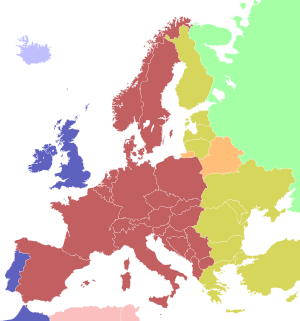
Moscow serves as the reference point for the time zone used in most of European Russia, Belarus and the Republic of Crimea. The areas operate in what is referred to in international standards as Moscow Standard Time (MSK, МСК), which is 3 hours ahead of UTC, or UTC+3. Daylight saving time is no longer observed. According to the geographical longitude the average solar noon in Moscow occurs at 12:30.[15]
المناخ
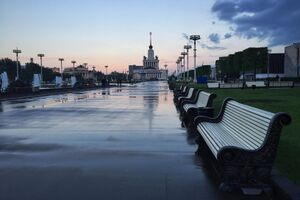
Moscow has a humid continental climate (Köppen: Dfb) with long, cold (although average by Russian standards) winters usually lasting from mid-November to the end of March, and warm summers. More extreme continental climates at the same latitude- such as parts of Eastern Canada or Siberia- have much colder winters than Moscow, suggesting that there is still significant moderation from the Atlantic Ocean despite the fact that Moscow is far from the sea. Weather can fluctuate widely, with temperatures ranging from −25 °C (−13 °F) in the city and −30 °C (−22 °F) in the suburbs to above 5 °C (41 °F) in the winter, and from 10 to 35 °C (50 to 95 °F) in the summer.[16]
Typical high temperatures in the warm months of June, July and August are around a comfortable 20 to 26 °C (68 to 79 °F), but during heat waves (which can occur between May and September), daytime high temperatures often exceed 30 °C (86 °F), sometimes for a week or two at a time. In the winter, average temperatures normally drop to approximately −10 °C (14 °F), though almost every winter there are periods of warmth with day temperatures rising above 0 °C (32 °F), and periods of cooling with night temperatures falling below −20 °C (−4 °F). These periods usually last about a week or two. The growing season in Moscow normally lasts for 156 days usually around May 1 to October 5.[17]
The highest temperature ever recorded was 38.2 °C (100.8 °F)[18] at the VVC weather station and 39.0 °C (102.2 °F) in the center of Moscow and Domodedovo airport on July 29, 2010 during the unusual 2010 Northern Hemisphere summer heat waves. Record high temperatures were recorded for January, March, April, May, July, August, November, and December in 2007–2014.[19] The average July temperature from 1981 to 2010 is 19.2 °C (66.6 °F). The lowest ever recorded temperature was −42.1 °C (−43.8 °F) in January 1940. Snow, which is present for about five months a year, often begins to fall mid October, while snow cover lies in November and melts at the beginning of April.
| بيانات مناخ موسكو (فترة 2001-2011، مطار ڤنوكوڤو) | |||||||||||||
|---|---|---|---|---|---|---|---|---|---|---|---|---|---|
| الشهر | يناير | فبراير | مارس | أبريل | مايو | يونيو | يوليو | أغسطس | سبتمبر | اكتوبر | نوفمبر | ديسمبر | العام |
| العظمى المتوسطة °س (°ف) | -4.8 (23.4) |
-5.1 (22.8) |
2.7 (36.9) |
11.4 (52.5) |
18.9 (66) |
21.6 (70.9) |
26.0 (78.8) |
23.0 (73.4) |
16.7 (62.1) |
8.6 (47.5) |
2.1 (35.8) |
-3.4 (25.9) |
9٫81 (49٫66) |
| المتوسط اليومي °س (°ف) | -6.4 (20.5) |
-7.6 (18.3) |
-0.8 (30.6) |
6.8 (44.2) |
13.6 (56.5) |
16.7 (62.1) |
20.8 (69.4) |
18.2 (64.8) |
12.5 (54.5) |
6.1 (43) |
0.5 (32.9) |
-4.9 (23.2) |
6٫29 (43٫33) |
| الصغرى المتوسطة °س (°ف) | -8.2 (17.2) |
-10.1 (13.8) |
-4.1 (24.6) |
2.2 (36) |
8.2 (46.8) |
11.8 (53.2) |
15.6 (60.1) |
13.4 (56.1) |
8.4 (47.1) |
3.6 (38.5) |
-0.9 (30.4) |
-6.5 (20.3) |
2٫78 (37٫01) |
| Sunshine hours | 37 | 65 | 142 | 213 | 274 | 299 | 323 | 242 | 171 | 89 | 33 | 14 | 1٬902 |
| Source: www.weatheronline.co.uk
"www.weatheronline.co.uk". Retrieved 2011. | |||||||||||||
رئاسة أكاديمية العلوم الروسية
الدار العالمي للموسيقى بموسكو وسويسوتيل Krasnye Holmy
قوس النصر في نهج كوتوزوڤ, مكرّس للانتصار على جيش ناپوليون
Old جسر أندرييڤسكي
وزارة الخارجية وجسر بورودينسكي
Moscow International Business Center, Tower 2000
مونوريل موسكو
Kotelnicheskaya Embankment Building
نافورة "صداقة الشعوب" في مركز معارض كل روسيا
التقسيمات الإدارية والحكومة
 مقالة مفصلة: الأقسام الادارية لموسكو
مقالة مفصلة: الأقسام الادارية لموسكو
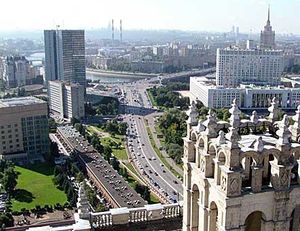
يَحكم موسكو مجلس المدينة المكون من 500 نائب ينتخبون لمدة خمس سنوات، وكل نائب يمثل منطقة. قبل عام 1990م، كان يترشح نائب واحد عن كل منطقة، فيُنتخَب عضوًا إذا حصل على أغلبية كبيرة من الأصوات. وفي مارس عام 1990م سُمح بترشيح أكثر من نائب في المنطقة الواحدة، ويفوز النائب الحاصل على نسبة50% من الأصوات على الأقل، وإذا لم يحصل أحد على هذه النسبة من الأصوات، تُعقد انتخابات حاسمة. وكان المجلس ينتخب أحد أعضائه، ليشغل منصب المحافظ، ومنذ يونيو 1991م أصبح الشعب ينتخب المحافظ مباشرة.
قُسّمت موسكو إلى 10 مناطق إدارية. يُعين المحافظ حاكمًا لكل منطقة، ويُدير الحاكم وموظفوه الخدمات وسياسة منطقته. وقُسِّمت موسكو أيضًا إلى مناطق محلية، وتُعيَّن فيها لجنة حكومية مسؤولة عن إدارة شؤونها المحلية.

التقسيمات الإدارية
الأكروگات الادارية لموسكو: 1. City of Zelenograd 2. Northern 3. North-Eastern 4. North-Western 5. Central 6. Eastern 7. Southern 8. South-Eastern 9. South-Western 10. Western]]
السكان
يدعى سكان موسكو الموسكويون، وهم خليط من عدة جنسيات، يشكل الروس الغالبية العظمى منهم. ومن الجنسيات، الأوكرانيون، والتتار، والأرمن. وتحاول الحكومة تحديد عدد سكان المدينة عن طريق إصدار تصاريح إقامة خاصة تسمى بروبيسكا للسكن في المدينة. يعيشون في شقق سكنية مكونة من غرفة واحدة أو غرفتين، والمدينة تعاني أزمة سكنية حادة. في موسكو جامعتان و 75 معهداً للتعليم العالي، وقد حرَّمت الحكومة السوڤييتية ممارسة الشعائر الدينية، لكن حرية العبادة أصبحت اليوم متاحة إذ ينتمي معظم سكان المدينة إلى الكنيسة الأرثوذكسية. ومن المشكلات الاجتماعية المهمة التي تعانيها موسكو: ارتفاع معدلات الجريمة وتعاطي المخدرات و الإدمان على الخمور و كثرة عدد المتشردين والتلوث البيئي وقلة المياه وتلوثها.
| التعداد التاريخي | ||
|---|---|---|
| السنة | تعداد | ±% |
| 1897 | 1٬038٬625 | — |
| 1926 | 2٬019٬500 | +94.4% |
| 1939 | 4٬137٬000 | +104.9% |
| 1959 | 5٬032٬000 | +21.6% |
| 1970 | 6٬941٬961 | +38.0% |
| 1979 | 7٬830٬509 | +12.8% |
| 1989 | 8٬769٬117 | +12.0% |
| 2002 | 10٬382٬754 | +18.4% |
| 2010 | 11٬514٬330 | +10.9% |
| Population size may be affected by changes on administrative divisions. | ||
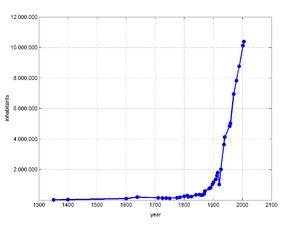
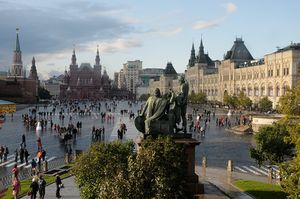
الإسكان
يعيش معظم الموسكويين في شقق سكنية تتكون من غرفة أو غرفتين، وتقع غالبية الشقق في مبانٍ عالية شيدت في الخمسينيات. ويعاني سكان موسكو من أزمة سكنية وسوء في حالة المباني. وقد تنتظر العائلات عدة سنوات حتى تحصل على شقق خاصة بها.
التعليم
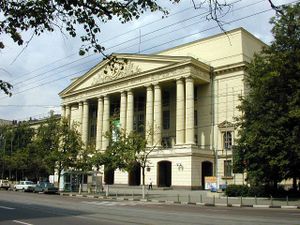
يوجد في موسكو نحو 75 معهدا للتعليم العالي منها جامعتان: جامعة موسكو، وجامعة الصداقة. وتختص المعاهد الأخُرى في تدريب الطلاب في حقول معينة مثل الهندسة والطب. أسست جامعة موسكو في عام 1755م، وتعد أكبر جامعة في روسيا، حيث تضمُّ 28,000 طالب. وأسست جامعة الصداقة في عام 1960، وتجتذب الطلاب من أفريقيا وآسيا وأمريكا الجنوبية.
يذهب أطفال موسكو كبقية الروس إلى المدارس لمدة 11 سنة، من عمر 6 إلى 17 سنة. ويوجد في موسكو نحو 1,300 مدرسة ابتدائية وثانوية عامة، ونحو 150 مدرسة مهنية.
الدين
Christians form the majority of the city's population; most of whom adhere Russian Orthodox Church. The Patriarch of Moscow serves as the head of the church and resides in the Danilov Monastery. Moscow was called the "city of 40 times 40 churches"—prior to 1917. Moscow is Russia's capital of Eastern Orthodox Christianity, which has been the country's traditional religion.
Other religions practiced in Moscow include البوذية، الهندوسية، الإسلام، Judaism, Yazidism, and Rodnovery. The Moscow Mufti Council claimed that Muslims numbered around 1.5 million of 10.5 million of the city's population in 2010;[22] There are four mosques in the city.[23]
الثقافة
الفنون. تُعْد موسكو مركزًا ثقافيًا روسيًا ودوليًا. فيعرض مسرح البولشوي المسرحيات الموسيقية (الأوبرا) والرقص الإيقاعي (الباليه). وأصبحت مؤسسة الباليه المسماة مسرح باليه البولشوي، مشهورة عالمياً. وتوجد مسارح أخرى مشهورة مثل مسرح مالي، ومسرح موسكو للفن.
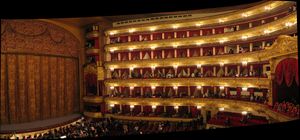
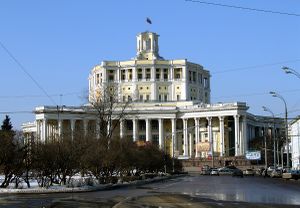
وفي المدينة 75 متحفاً وصالة عرض مثل: المتحف التاريخي الوطني، ومتحف لينين المركزي، والمتحف المركزي للثورة، والمتحف الحربي. وفي موسكو 1200 مكتبة أهمها مكتبة لينين الوطنية، وعدد كبير من مراكز الترويح مثل: ملعب لوزنيكي Luzhniki و حديقة گوركي التي تضم مسارح في الهواء الطلق، وأماكن لركوب الزوارق والتزلج على الجليد، وكرة المضرب والسيرك الروسي الشهير. ولعل أهم مناطق موسكو الشعبية منطقة «أرپات» التي تقع وسط المدينة والغنية بمتاجرها، وفنادقها ومطاعمها ومكتباتها وفرق الموسيقى الشعبية والفنانين المتجولين وحلقات النقاش الفكري والسياسي. وتعدّ موسكو عقدة مواصلات مهمة برية وحديدية وجوية باتجاه البلاد الروسية كافة. تمتلك المدينة أربعة مطارات. ويتم الانتقال داخل المدينة بوساطة قطار الأنفاق (المترو)، إذ تمتلك 140 محطة رائعة الجمال مزدانة بالرخام واللوحات والثريات والتماثيل حيث ينقل المترو 7 ملايين شخص يومياً.
المتاحف والمكتبات
في موسكو نحو 75 متحفًا وصالة عرض. يجتذب المتحف التاريخي الوطني طلاب التاريخ الروسي، ويعرض في متحف لينين المركزي والمتحف المركزي للثورة معروضات تخص الثورة الروسية، كما تعرض ثروات القياصرة في المتحف الحربي في الكرملين. ويشاهد في معرض الإنجازات الاقتصادية أهم الإنجازات في مجالات العلوم والتكنولوجيا.
في موسكو نحو 1,200 مكتبة، وتعد مكتبة لينين الوطنية أكبر مكتبة في روسيا، وهي أيضًا من أكبر المكتبات في العالم.
الترويح
في موسكو عدد كبير من الأماكن التَّرويحيَّة. أنُشئ ملعب لوزنيكي في عام 1956، وتم توسيعه لاستضافة الألعاب الأوليمبية في عام 1980، ويسع الملعب الكبير 103,000 متفرج، ويستعمل لكرة القدم، اللعبة الأكثر شعبية في روسيا.
أشهر المراكز التَّرويحيَّة هي حديقة جوركي، التي تحتوي على مسرح في الهواء الطلق، وأماكن ركوب الزوارق، والتزلج على الجليد، وكرة المضرب (التنس). وتم افتتاح الحديقة في عام 1925، وقد بلغت مساحتها نحو 120 هكتارًا.
الأربات منطقة شعبية، تقع في وسط موسكو، ويوجد فيها عدد من المتاجر والمطاعم، ومكتبات بيع الكتب. وتنتشر فيها فرق الموسيقى الشعبية والفنانون المتجولون، والمجادلات السياسية، تجعل منها منطقة حيوية تجذب الزوار.
ومن الأنشطة التَّرويحيَّة الأخرى والمهمة لعبة الشطرنج، وزيارة حدائق الحيوانات، ومشاهدة السيرك الروسي الشهير.
المتنزهات والمعالم
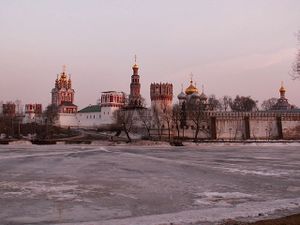 Novodevichy Convent is just one of many medieval monuments that dot the city. |
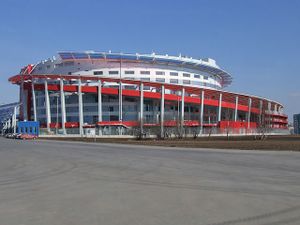 قصر الجليد, بني في 2006 |
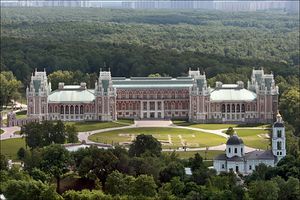
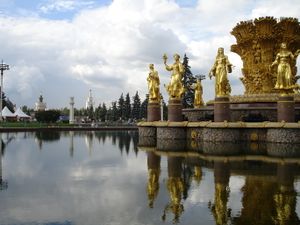
حلقات موسكو
 الرياضة
الرياضة

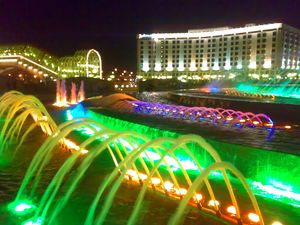
التعليم والعلوم
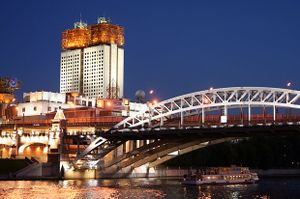
المواصلات
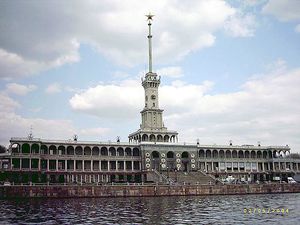
المونوريل
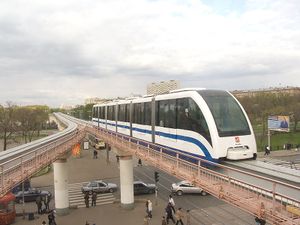
تُعد موسكو مركز النقل في روسيا، فتنتشر الطرق والسكك الحديدية من موسكو إلى جميع مناطق روسيا. وتوجد في موسكو أربعة مطارات رئيسية أكبرها مطار دوموديدوفو، الذي يقع جنوبي موسكو. وتصل قناة موسكو المدينة بنهر الفولجا، أطول الأنهار الأوروبية.
يوجد في موسكو 140 محطة مترو رائعة الجمال، وتختلف التصاميم من محطة إلى أخرى، والكثير منها مزدان بالثّريات، والرسومات والتماثيل والرخام. والمترو سكك حديدية تمتد نحو 225كم، وتم افتتاحه في عام 1935م. ينقل المترو أكثر من 7 ملايين شخص يوميًا.
النقل الجوي
النقل المائي
السكك الحديدية
المترو
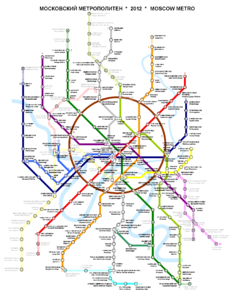
الحافلات والترولي باس
الترام
التاكسي
الطرق
وسائل الاتصال
يصدر في موسكو عدد كبير من الصحف والمجلات، وأشهرها صحيفة برافدا (الحقيقة) وأزفستيا (الأخبار). وتعد جريدتا موسكو المساء وأخبار موسكو من الصحف اليومية المحلية.
تسيطر الحكومة على إذاعة موسكو التى تبث على أربع موجات، وتسيطر أيضًا على محطة التلفاز بقناتيها. كما توجد عدة محطات خاصة تبث من مدينة سانت بطرسبرج.
الاقتصاد
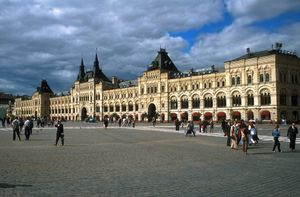
الصناعة
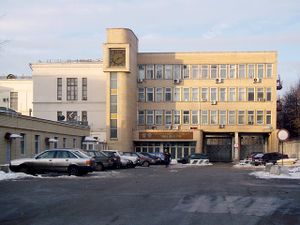
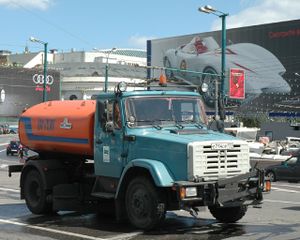
وموسكو أهم مدينة صناعية في روسيا، إذ تنتج ما بين 15% - 20% من إجمالي الصناعة الروسية: الصلب، الآلات، السيارات، الطائرات، الكيميائيات، المنسوجات، الأدوات الكهربائية، آلات القياس، الأسلحة، الآلات الزراعية، المواد الغذائية المصنعة.[24]
تكاليف المعيشة
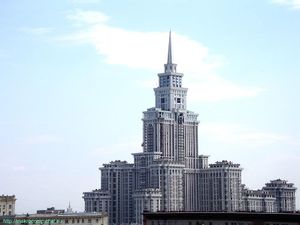
التطورات المستقبلية
اجمالى القوى العاملة باعداد أكثر من 5 ملايين (او 8 ٪ من اجمالي العمالة روسيا). المتقاعدون حساب 24 ٪ بالنسبة للسكان ، والسكان تحت سن 16 هي 18 ٪. 2.2%. وتبلغ نسبة البطالة 2،2 ٪ . الادنى في روسيا . تخصص ميزانيه المدينة 40 ٪ من نفقاتها للاغراض الاجتماعية.
أصبحت موسكو عاصمة لروسيا في عهد الملك إيڤان الرابع.
أفق المدينة
العمارة
Moscow's architecture is world-renowned. Moscow is the site of Saint Basil's Cathedral, with its elegant onion domes, as well as the Cathedral of Christ the Savior and the Seven Sisters. The first Kremlin was built in the middle of the 12th century.
Medieval Moscow's design was of concentric walls and intersecting radial thoroughfares. This layout, as well as Moscow's rivers, helped shape Moscow's design in subsequent centuries.
The Kremlin was rebuilt in the 15th century. Its towers and some of its churches were built by Italian architects, lending the city some of the aurae of the renaissance. From the end of the 15th century, the city was embellished by masonry structures such as monasteries, palaces, walls, towers, and churches.
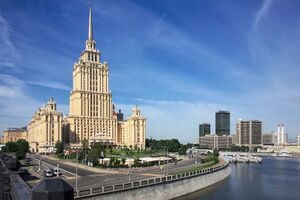
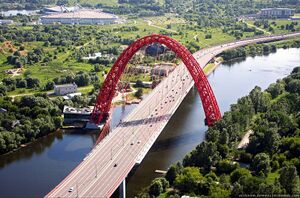
The Soviet goal of providing housing for every family, and the rapid growth of Moscow's population, led to the construction of large, monotonous housing blocks. Most of these date from the post-Stalin era and the styles are often named after the leader then in power (Brezhnev, Khrushchev, etc.). They are usually badly maintained.
Although the city still has some five-story apartment buildings constructed before the mid-1960s, more recent apartment buildings are usually at least nine floors tall, and have elevators. It is estimated that Moscow has over twice as many elevators as New York City and four times as many as Chicago. Moslift, one of the city's major elevator operating companies, has about 1500 elevator mechanics on call, to release residents trapped in elevators.[25]
Stalinist-era buildings, mostly found in the central part of the city, are massive and usually ornamented with Socialist realism motifs that imitate classical themes. However, small churches—almost always Eastern Orthodox– found across the city provide glimpses of its past. The Old Arbat Street, a tourist street that was once the heart of a bohemian area, preserves most of its buildings from prior to the 20th century. Many buildings found off the main streets of the inner city (behind the Stalinist façades of Tverskaya Street, for example) are also examples of bourgeois architecture typical of Tsarist times. Ostankino Palace, Kuskovo, Uzkoye and other large estates just outside Moscow originally belong to nobles from the Tsarist era, and some convents, and monasteries, both inside and outside the city, are open to Muscovites and tourists.
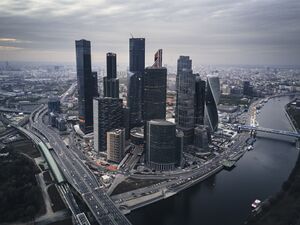
Attempts are being made to restore many of the city's best-kept examples of pre-Soviet architecture. These restored structures are easily spotted by their bright new colors and spotless façades. There are a few examples of notable, early Soviet avant-garde work too, such as the house of the architect Konstantin Melnikov in the Arbat area. Many of these restorations were criticized for alleged disrespect of historical authenticity. Facadism is also widely practiced.[26] Later examples of interesting Soviet architecture are usually marked by their impressive size and the semi-Modernist styles employed, such as with the Novy Arbat project, familiarly known as "false teeth of Moscow" and notorious for the wide-scale disruption of a historic area in central Moscow involved in the project.
Plaques on house exteriors will inform passers-by that a well-known personality once lived there. Frequently, the plaques are dedicated to Soviet celebrities not well known outside (or often, like with decorated generals and revolutionaries, now both inside) of Russia. There are also many "museum houses" of famous Russian writers, composers, and artists in the city.
Moscow's skyline is quickly modernizing, with several new towers under construction.
المنتزهات والمعالم
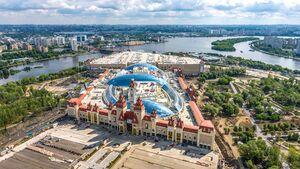
Izmaylovsky Park, created in 1931, is one of the largest urban parks in the world along with Richmond Park in London. Its area of 15.34 square kilometres (5.92 sq mi) is six times greater than that of Central Park in New York.[27]
Sokolniki Park, named after the falcon hunting that occurred there in the past, is one of the oldest parks in Moscow and has an area of 6 square kilometres (2.3 sq mi). A central circle with a large fountain is surrounded by birch, maple and elm tree alleys. A labyrinth composed of green paths lies beyond the park's ponds.
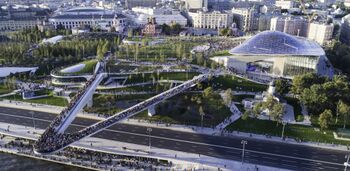
|
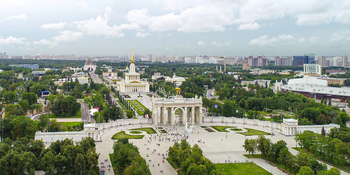
|
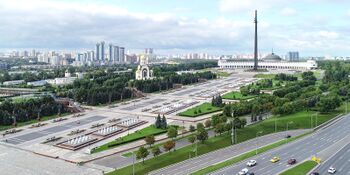
|
| Zaryadye Park | VDNKh | Victory park on Poklonnaya Hill |
حلقات موسكو
Moscow's road system is centered roughly on the Kremlin at the heart of the city. From there, roads generally span outwards to intersect with a sequence of circular roads ("rings").
حلقات النقل في موسكو
| الطول | الاسم | النوع |
|---|---|---|
| 9 km | Boulevard Ring – Bulvarnoye Koltso (not a full ring) | Road |
| 16 km | Garden Ring – Sadovoye Koltso ("B") | Road |
| 19 km | Koltsevaya Line (Line 5) | Metro |
| 35 km | Third Ring Road – Third Transport Ring – Tretye Transportnoye Koltso (TTK) | Road |
| 54 km | Little Ring of the Moscow Railway, re-opened as Moscow Central Ring (MCC) – Line 14 | Railway |
| 20.2 km | Bolshaya Koltsevaya line – Line 11 | Metro |
| 109 km | Moscow Automobile Ring Road – Moskovskaya Koltsevaya Avtomobilnaya Doroga (MKAD) | Road |
الإعلام
Moscow is the headquarters of nearly all Russian nationwide television networks, radio stations, newspapers and magazines.
الصحف
الراديو والتلفزيون
شبكات تلفزيون موسكو(باللغة الروسية) :
Moscow radio stations:
|
|
|
|
شخصيات شهيرة
العلاقات الدولية
المدن الشقيقة
|
كتب
- Caroline Brooke. Moscow: A Cultural History. 2006 (Oxford University Press)
- Karel Neubert. "Portrait of Moscow". 1964
- Albert J. Schmidt. "The Architecture and Planning of Classical Moscow: A Cultural History". 1989
- Kathleen Berton. "Moscow: An Architectural History". St. Martin's, 1991
- Marcel Girard. "Splendours of Moscow and Its Surroundings", trans. from French. 1967
- John Bushnell. "Moscow Graffiti: Language and Subculture". Unwin Hyman, 1990
- S.S. Hromov et al. (eds.). "History of Moscow: An Outline", trans. from Russian. 1981
- Galina Dutkina. "Moscow Days: Life and Hard Times in the New Russia". Trans. Catherine Fitzpatrick. Kodansha America, 1995
انظر أيضاً
- 1904 Moscow tornado
- تاريخ روسيا
- List of cities by population
- List of mayors of Moscow
- List of Moscow tourist attractions
- Moscow Millionaire Fair
- Moscow-City
- Moya Moskva (My Moscow) - Anthem of Moscow
- موسكڤي
- روما الثالثة
- 1998 World Youth Games the first world youth games
- Moscow International Business Center
- Moscow metropolitan area
Lists:
هامش ومصادر
- ^ Comins-Richmond, Walter. "The History of Moscow". Occidental College. Archived from the original on May 17, 2006. Retrieved July 3, 2006.
- ^ "The Moscow Statute". Moscow City Duma. Moscow City Government. June 28, 1995. Archived from the original on August 23, 2011. Retrieved September 29, 2010.
The supreme and exclusive legislative (representative) body of the state power in Moscow is the Moscow City Duma.
- ^ أ ب "The Moscow City Mayor". Government of Moscow. Archived from the original on August 23, 2011. Retrieved March 18, 2010.
- ^ "Общая площадь Москвы в длинну и ширину". RosInfoStat. Archived from the original on December 3, 2021. Retrieved June 2, 2021.
- ^ Including Moscow Oblast (8,524,665)
- ^ "Оценка численности постоянного населения по субъектам Российской Федерации". Federal State Statistics Service. Archived from the original on September 1, 2022. Retrieved 1 September 2022.
- ^ خطأ استشهاد: وسم
<ref>غير صحيح؛ لا نص تم توفيره للمراجع المسماةUrban - ^ Moscow metropolitan area
- ^ "Валовой региональный продукт по субъектам Российской Федерации в 2016-2021гг". www.rosstat.gov.ru. Archived from the original on 31 March 2023. Retrieved 21 August 2023.
- ^ "Об исчислении времени". Официальный интернет-портал правовой информации (in الروسية). Archived from the original on June 22, 2020. Retrieved 19 January 2019.
- ^ "Автомобильные коды регионов России-2022: таблица с последними изменениями". РИА Новости (in الروسية). November 16, 2022. Archived from the original on November 28, 2022. Retrieved 2022-11-28.
- ^ "The Unending Frontier: An Environmental History of the Early Modern World". John F. Richards (2006). University of California Press. p. 260. ISBN 0-520-24678-0
- ^ Melikishvili, Alexander (2006). "Genesis of the anti-plague system: the Tsarist period" (PDF). Critical Reviews in Microbiology. 36 (1): 19–31. CiteSeerX 10.1.1.204.1976. doi:10.1080/10408410500496763. PMID 16610335. S2CID 7420734. Archived from the original (PDF) on November 23, 2009. Retrieved March 22, 2020.
- ^ Памятник природы "Высшая точка Москвы – 255 м над уровнем моря (Теплый Стан)" (in الروسية). www.darwin.museum.ru. Archived from the original on August 25, 2007. Retrieved April 29, 2009.
- ^ "Time in Moscow, Russia". Retrieved March 31, 2018.
- ^ Погода и Климат – Климатический монитор: погода в Москве [The weather in Moscow. The air temperature and rainfall. June 2010] (in الروسية). Pogoda.ru.net. Retrieved March 12, 2013.
- ^ https://weatherspark.com/y/100524/Average-Weather-in-Moscow-Russia-Year-Round
- ^ "Climate monitoring". Retrieved July 27, 2006.
- ^ "Pogoda.ru.net" (in الروسية). Retrieved December 15, 2012.
- ^ "Об оскорблении религиозных чувств" (in الروسية). Фонд Общественное Мнение, ФОМ (Public Opinion Foundation). 17 November 2020. Retrieved 21 April 2021.
- ^ "Об оскорблении религиозных чувств" (in الروسية). Фонд Общественное Мнение, ФОМ (Public Opinion Foundation). 17 November 2020. Retrieved 21 April 2021.
- ^ Maxim Kireev. "Planned Mosque Sparks Controversy in Russia". Der Spiegel.
- ^ Kiran Moodley. "Eid al-Fitr 2015: Drone shows huge crowds celebrating the end of Ramadan in Moscow". The Independent. Retrieved February 12, 2016.
- ^ موسكو, الموسوعة العربية
- ^ McGrane, Sally (December 4, 2012), "The Elevator-Rescue Teams of Moscow", The New Yorker, https://www.newyorker.com/online/blogs/culture/2012/12/the-elevator-rescue-teams-of-moscow.html
- ^ "Moscow Architecture Preservation Society". Maps-moscow.com. April 17, 2006. Archived from the original on January 11, 2008. Retrieved May 5, 2009.
- ^ خطأ استشهاد: وسم
<ref>غير صحيح؛ لا نص تم توفيره للمراجع المسماةgreendress - ^ "Twin Towns". www.amazingdusseldorf.com. Retrieved 2009-10-29.
- ^ "Sister Cities of Manila". 2008–2009 City Government of Manila. Retrieved 2009-07-02.
{{cite web}}: External link in|publisher= - ^ "Prague Partner Cities" (in Czech). 2009 Magistrát hl. m. Prahy. Retrieved 2009-07-02.
{{cite web}}: External link in|publisher= - ^ Moscow and Rejkjavik sister cities. . Retrieved on 2008-03-11
- ^ "Twinning Cities: International Relations" (PDF). Municipality of Tirana. www.tirana.gov.al. Retrieved 2009-06-23.
- ^ Twinning Cities: International Relations. Municipality of Tirana. www.tirana.gov.al. Retrieved on 2008-01-25.
- ^ "Cooperation Internationale" (in French). © 2003–2009 City of Tunis Portal. Retrieved 2009-07-31.
{{cite web}}: CS1 maint: unrecognized language (link) - ^ "Miasta partnerskie Warszawy". um.warszawa.pl. Biuro Promocji Miasta. 2005-05-04. Archived from the original on 2007-10-11. Retrieved 2008-08-29.
قائمة المراجع
- Caroline Brooke. Moscow: A Cultural History. 2006 (Oxford University Press)
- William Craft Brumfield. A History of Russian Architecture (Seattle: Univ. of Washington Press, 2004) ISBN 9780295983943
- Karel Neubert. "Portrait of Moscow". 1964
- Albert J. Schmidt. The Architecture and Planning of Classical Moscow: A Cultural History. 1989
- Kathleen Berton. Moscow: An Architectural History. St. Martin's, 1991
- Marcel Girard. "Splendours of Moscow and Its Surroundings", trans. from French. 1967
- John Bushnell. "Moscow Graffiti: Language and Subculture". Unwin Hyman, 1990
- S.S. Hromov et al. (eds.). "History of Moscow: An Outline", trans. from Russian. 1981
- Galina Dutkina. "Moscow Days: Life and Hard Times in the New Russia". Trans. Catherine Fitzpatrick. Kodansha America, 1995.
- "Mosca 1990–1993" by Giuseppe D'Amato in Il Diario del Cambiamento. Urss 1990 – Russia 1993. Greco&Greco editori, Milano, 1998. ISBN 88-7980-187-2 (The Diary of the Change. USSR 1990 – Russia 1993) Book in Italian.
المواقع الرسمية
- Moscow.ru – Official Moscow Site (بالروسية), (إنگليزية), (بالإسپانية), (بالألمانية), (بالفرنسية), (صينية)
- Committee for Tourism of Moscow City Government
- Official Moscow Administration Site (بالروسية)
- Official Site of Moscow Subway (إنگليزية), (بالروسية)
- Main Moscow Russian Forum
وصلات خارجية
- خريطة رقمية تفاعلية لموسكو (إنگليزية) (بالروسية)
- الموقع الرسمي للحكم المحلي لموسكو (بالروسية)
- 360 دليل بانورامي لموسكو (إنگليزية) (بالروسية)
- موقع موسكو المعاصرة (بالروسية)
- دليل موسكو (tr)
- موسكو ڤيديو
- لجنة السياحة بحكومة موسكو المحلية
- WikiMapia: Moscow - aerial, satellite view of Moscow showing city landmarks
- Virtual Moscow. It integrates Google Maps with significant tourist locations, vivid photographs and a large number of great panoramic views.
- Historical weather records for Moscow
- The Luzhniki Stadium has been chosen by UEFA to host the 2008 UEFA Champions League final
- دليل تليفونات موسكو
- Moscow on Wikitravel
- Moscow.Info
- مناظر من موسكو، صور
- الطقس في موسكو, 6 أيام
- Christmas Moscow. معرض صور
| Find more about Moscow at Wikipedia's sister projects | |
| Definitions from Wiktionary | |
| Media from Commons | |
| Quotations from Wikiquote | |
| Source texts from Wikisource | |
| Textbooks from Wikibooks | |
| Learning resources from Wikiversity | |
- موسكو travel guide from Wikitravel
- Moscow Railway Museum Rizhsky Rail Terminal / Rizhskaya
- Lenin's Funeral Train Museum at Paveletsky Rail Terminal
- Moscow Russia Insider's Guide
وسائل الإعلام
- The Moscow Times - official site of Moscow's leading English-language newspaper
- The Moscow News - one of Moscow's oldest English-language newspapers
- Russia Profile - In-depth coverage of international, political, business and cultural events in Russia (in English)
- Moscow House of Photography
- Some images from Ukraina Hotel
- CS1 uses الروسية-language script (ru)
- CS1 الروسية-language sources (ru)
- الصفحات بخصائص غير محلولة
- Short description is different from Wikidata
- Missing redirects
- Pages using multiple image with auto scaled images
- Coordinates on Wikidata
- Articles with hatnote templates targeting a nonexistent page
- Articles containing روسية-language text
- Articles with unsourced statements from May 2011
- Pages using multiple image with manual scaled images
- قوائم غير مكتملة
- المدن المضيفة للألعاب الاولمبية الصيفية
- الحلقة الذهبية في روسيا
- Golden Ring of Russia
- عواصم اوروبا
- موسكو
- مدن اتحادية في روسيا
- المدن المضيفة للألعاب الاوليمبية الصيفية
- المدن البطلة بالاتحاد السوفييتي
- عواصم أوروبا
- عواصم آسيا
- روسيا
- مدن روسيا


